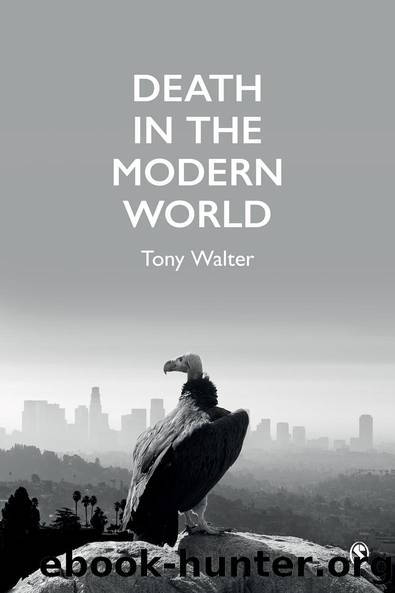Death in the Modern World by Tony Walter

Author:Tony Walter [Walter, Tony]
Language: eng
Format: epub
Tags: Social Science, Sociology, General, Death & Dying
ISBN: 9781526480088
Google: Tka3DwAAQBAJ
Publisher: SAGE
Published: 2020-01-09T04:22:54+00:00
Funerals
The preceding paragraphs gave dramatic examples of conflict between the political order and family grief. Chapter 12 will consider the treatment of the war dead by democratic states which somehow have to both honour family grief and display the dead as national heroes. There are also examples of the state imposing a new kind of funeral that does not, as in Japan, support the family but downgrades it and displays instead the political order. In most cases, Durkheimian sociology is correct: in funeral rites, mourners gather together to affirm the solidarity of the group over death. The question is: which group? In the American or European war cemetery, the group is manifestly not family but nation. But family is not undermined. In some communist countries, by contrast, funerals that display the deceased as a model citizen affirm socialism in an effort to undermine the family.2
I have mentioned already China and Vietnam. Chinaâs Cultural Revolution stopped the veneration of family ancestors; funerals were simple, with family no more important than workmates; only the funerals of important local or national party members (ultimately Mao himself) were on any scale (Whyte, 1988). But in a more capitalist twenty-first century economy, some rural Chinese are reverting to family ancestors; for others there is anomie, uncertainty. According to one informant, âNo one knows the old ritual, and no one believes in the old religions anymore, but the practices put in place by the CCP [Communist Party of China] are discreditedâ (Goss and Klass, 2005: 202).
A more recent study, âDying socialist in capitalist Shanghaiâ (Liu, 2015), tells a somewhat different story. Secular civil funerals were invented by the Republican government in the early twentieth century before the 1949 Communist Revolution. They were then promoted by the CCP from the late 1960s, with the following format (p. 253):
The Master/Mistress of Ceremonies announces the beginning of the memorial meeting.
All commemorate the deceased in silence while the funeral dirge is played.
The work unit representative gives a memorial speech.
The representative of the bereaved gives a thank you speech.
All collectively bow to the deceased three times.
Farewell Ceremony.
Download
This site does not store any files on its server. We only index and link to content provided by other sites. Please contact the content providers to delete copyright contents if any and email us, we'll remove relevant links or contents immediately.
Nudge - Improving Decisions about Health, Wealth, and Happiness by Thaler Sunstein(7662)
The Fire Next Time by James Baldwin(5390)
iGen by Jean M. Twenge(5387)
Adulting by Kelly Williams Brown(4536)
The Sports Rules Book by Human Kinetics(4348)
The Hacking of the American Mind by Robert H. Lustig(4342)
The Ethical Slut by Janet W. Hardy(4219)
Captivate by Vanessa Van Edwards(3818)
Mummy Knew by Lisa James(3660)
In a Sunburned Country by Bill Bryson(3509)
The Worm at the Core by Sheldon Solomon(3457)
Ants Among Elephants by Sujatha Gidla(3442)
The 48 laws of power by Robert Greene & Joost Elffers(3150)
Suicide: A Study in Sociology by Emile Durkheim(2990)
The Slow Fix: Solve Problems, Work Smarter, and Live Better In a World Addicted to Speed by Carl Honore(2979)
The Tipping Point by Malcolm Gladwell(2874)
Humans of New York by Brandon Stanton(2848)
Handbook of Forensic Sociology and Psychology by Stephen J. Morewitz & Mark L. Goldstein(2679)
The Happy Hooker by Xaviera Hollander(2673)
